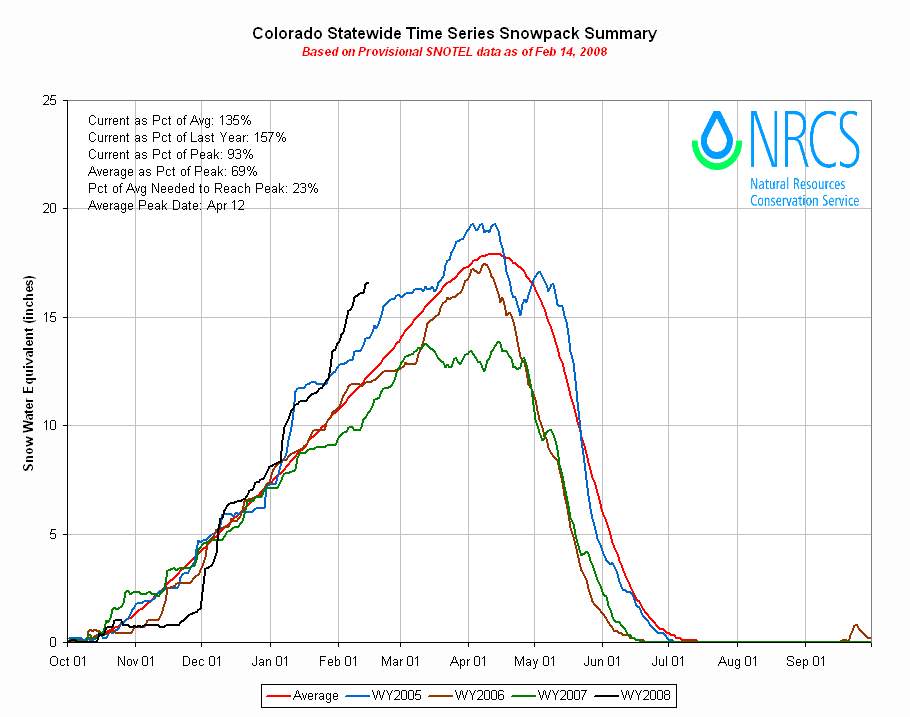
The figure above shows the snowpack in the state of Colorado for the past few years. The current level is higher than its been for a while. This is great news for just about everyone in Colorado — except seasonal climate forecasters, who had predicted a dry, warm winter, and were sticking to that forecast as recently as a month ago.
In today’s Denver Post our excellent local science reporter Katy Human takes a look at the forecasts and why forecasters have given in to the reality of massive snowfall totals here in Colorado:
Dry-winter forecasts were flat wrong this year for much of Colorado and the Southwest, and weather experts say they’re struggling to understand why the snow just keeps falling.
Some forecasters blame climate change, and others point to the simple vicissitudes of weather. Regardless, almost everyone called for a dry-to-normal winter in Colorado and the Southwest — but today, the state’s mountains are piled so thick with snow that state reservoirs could fill and floods could be widespread this spring.
“The polar jet stream has been on steroids. We don’t understand this. It’s pushing our limits, and it’s humbling,” said Klaus Wolter, a meteorologist with the National Oceanic and Atmospheric Administration and the University of Colorado at Boulder.
Wolter and NOAA both forecast a drier-than-average winter in most of Colorado. AccuWeather Inc. did the same, citing similar reasons: A La Niña weather system of cool, equatorial Pacific water had set up in the tropics last fall.
I have a lot of respect for Klaus, who is brave enough to put out forecasts in the public on time scales that will allow verification, and hence newspaper articles on his performance. Forecasting is not for the thin-skinned. But forecasts have other effects as well:
La Niña winters have almost always brought droughtlike conditions to the Southwest, as the jet stream ferries storms farther north.
But Arizona has been hit with record snowfall this winter, said Mark Hubble, a senior hydrologist with the Salt River Project in Arizona, the largest provider of water and power in Phoenix.
Dry forecasts last fall convinced Salt River Project managers to purchase about 20,000 acre-feet of water from the Central Arizona Project as a backup, Hubble said. An acre- foot of water is about enough for a family of four for one year.
“As it turns out, we didn’t need it — at all,” Hubble said. He could not estimate the financial losses to Salt River, because some payments are made in-kind, with water trades and offsets in the future.
So why did the forecasts bust this year? No one really knows.
Wolter said he’s troubled that his and other long-range forecasts have been off two years in a row now.
Last year, experts predicted a wet year from Southern California across to Arizona and southern Colorado, because of an El Niño weather system of warmer Pacific water.
Instead, drought worsened in the Southwest, capped by a huge fire season in Southern California.
“So we have two years in a row here where the atmosphere does not behave as we expect,” Wolter said. “Maybe global changes are pulling the rug out from underneath us. We may not know the answer for 10 years, . . . but one pet answer is that you should get more variability with global change.”
So I suppose we should add busted seasonal forecasts to our growing lists of things consistent with predictions of climate change. Making long term, unverifiable forecasts is sure a lot safer territory than predicting seasonal snowpack!
For further reading:
Pielke, Jr., R. A., 2000: Policy Responses to the 1997/1998 El Niño: Implications for Forecast Value and the Future of Climate Services. Chapter 7 in S. Changnon (ed.), The 1997/1998 El Niño in the United States. Oxford University Press: New York. 172-196. (PDF)

